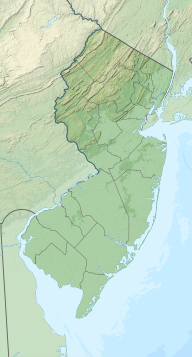Boonton Reservoir
| Boonton Reservoir | |
|---|---|
 Boonton Reservoir in the upper center, just north of Interstate 80 and just east of Interstate 287 | |
| Location | Boonton / Parsippany–Troy Hills Morris County, New Jersey |
| Coordinates | 40°52′57″N 74°24′29″W / 40.88250°N 74.40806°W |
| Type | Reservoir |
| Basin countries | United States |
| Water volume | 7,620,000,000 US gal (2.88×1010 L)[1] |
| Surface elevation | 305.25 ft (93.04 m)[1] |
| Settlements | Jersey City, New Jersey |
The Boonton Reservoir is a 700-acre (280 ha) reservoir located between Boonton and Parsippany–Troy Hills, New Jersey. Boonton, along with nearby Splitrock Reservoir, provides water for Jersey City, New Jersey.[2] It was formed by the construction of a dam on the Rockaway River completed in 1904[1] on the site of the original town of Boonton.[3]
On April 11, 1904, professional diver William Hoar was attempting to close an intake pipe in the new reservoir when the suction of the water caught Hoar's left leg between the pipe and the nearly 5,000-pound (2,300 kg) ball closing it. Despite extensive rescue efforts, Hoar would die after surviving 70 feet (21 m) underwater for 24 hours.[4][5][6][7][8]
On September 26, 1908, the reservoir's waters were the first municipal water supply in the US to be continuously chlorinated.[9][3] The chlorination system was devised by John L. Leal[10] and the facility was designed by George W. Fuller.[11]
In June 2014, Jersey City installed a new $5.8-million (equivalent to $7.35 million in 2023[12]) gravity pipeline that brings water from the reservoir to the on-site treatment facility. The new pipeline is more energy efficient and is expected to save the city $375,000 annually in electricity costs. It replaced the former pipeline which pumped water uphill to the treatment facility and was more energy-intensive.[13]
On September 28, 2018, officials from Jersey City and the Morris County Park Commission announced a plan to create a nature preserve and 7.7-mile (12.4 km) educational hiking trail around the reservoir that will allow for passive recreation while protecting the water supply with additional security measures.[14] Phase 1 of the trail construction was expected to break ground in 2022.[15]
Incidents
[edit]In March 2019, a body was found floating in the reservoir,[16] eventually identified as Boonton resident Sean Stohl who had been reported missing since November 2018.[17] On August 23, 2020, the body of a 55-year-old female was recovered by dive teams and a state police chopper.[18]
References
[edit]- ^ a b c "USGS Current Conditions for USGS 01380900 Boonton Reservoir at Boonton NJ". waterdata.usgs.gov. Retrieved May 31, 2019.
- ^ Zaremba, Justin (January 6, 2015). "DEP's $3.1 million purchase of Split Rock Reservoir in Rockaway a 'win-win', mayor says". nj.com. Retrieved May 6, 2020.
- ^ a b "Boonton 1890 - 1910 | Boonton, NJ". www.boonton.org. Retrieved May 31, 2019.
- ^ Denison, Lindsey (April 12, 1904). "A Fight for a Life". The Sun. New York City., cited in Harrington, Harry Franklin; Frankenberg, Theodore Thomas (1912). Essentials in Journalism: A Manual in Newspaper Making for College Classes. Boston, New York, Chicago, London: Ginn and Company. pp. 4–11. Retrieved January 4, 2023 – via Google Books.
- ^ "DIVER MET HIS DEATH He Is Imprisoned In Seventy Feet of Water at Boonton, N. J." The Bridgewater Herald. Vol. 10, no. 31. Bridgewater, Virginia. April 15, 1904. p. 2. Retrieved February 19, 2022 – via Virginia Chronicle.
- ^ "HOW "BILL" HOAR, DIVER, DIED. TERRIBLE STRUGGLE FOR LIFE. GALLANT FELLOW-WORKERS". The Examiner. Launceston, Tasmania. June 13, 1904. Page 7, column 2. Retrieved February 19, 2022 – via Trove.
- ^ Boonton Historical Society (2017). Boonton. Images of America. Charleston, South Carolina: Arcadia Publishing. p. 21. ISBN 978-1-4671-2447-8. Retrieved February 19, 2022 – via Google Books.
- ^ Moy, Jeffrey V. (March 25, 2022). "The Lost Village of Old Boonton: Its history and disappearance beneath the waters of the Rockaway River". General News. MorristownGreen.com. Retrieved March 27, 2022.
- ^ "A Public Health Giant Step: Chlorination of U.S. Drinking Water". Water Quality and Health Council. Retrieved May 6, 2020.
- ^ Leal, John L. (1909). "The Sterilization Plant of the Jersey City Water Supply Company at Boonton, N.J.". Proceedings American Water Works Association: 100–9.
- ^ Fuller, George W. (1909). "Description of the Process and Plant of the Jersey City Water Supply Company for the Sterilization of the Water of the Boonton Reservoir". Proceedings American Water Works Association: 110–34.
- ^ Johnston, Louis; Williamson, Samuel H. (2023). "What Was the U.S. GDP Then?". MeasuringWorth. Retrieved November 30, 2023. United States Gross Domestic Product deflator figures follow the MeasuringWorth series.
- ^ Bhattacharya, Sudip (November 7, 2014). "New $5.8M water pipeline operational, part of Jersey City's push for green technology". nj.com. Retrieved May 8, 2020.
- ^ Westhoven, William (September 28, 2018). "Officials celebrate launch of Boonton Reservoir recreation trail". Daily Record. Retrieved May 31, 2019.
- ^ Westhoven, William. "Recreation 7-mile loop trail around Boonton Reservoir a step closer to reality". Daily Record. Retrieved April 24, 2023.
- ^ Westhoven, William (March 4, 2019). "Investigation underway after body found in Boonton Reservoir". Daily Record. Retrieved May 31, 2019.
- ^ Kausch, Katie (March 6, 2019). "Body Found In Boonton Reservoir Identified As Missing Man". Parsippany, NJ Patch. Retrieved May 31, 2019.
- ^ "UPDATE: Body Of Local Mom Found Near Boonton Reservoir". Morris Daily Voice. August 24, 2020. Retrieved April 24, 2023.


